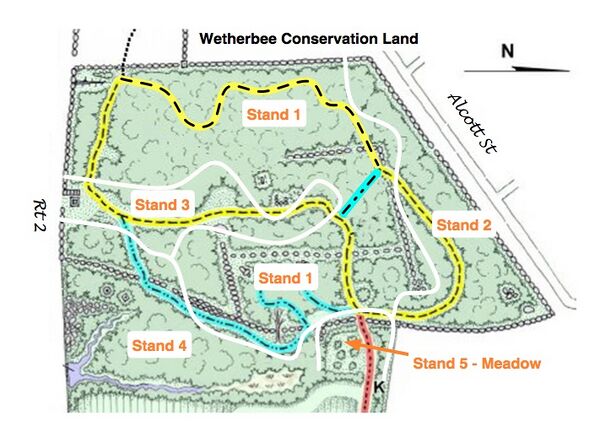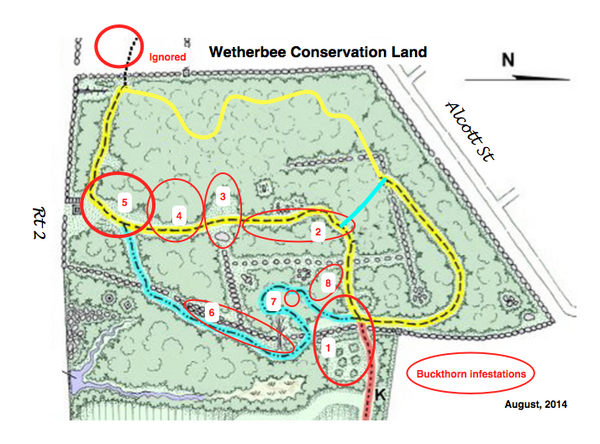Wetherbee
Wetherbee Land is one of Acton's conservation areas. It is located next to Rt. 2 in East Acton near the border with Concord. Over half of the land is actively farmed, with the rest wooded or meadow. This page discusses the unfarmed portion.
Forest Management Plan
In 2010, the Acton Conservation Commission requested that a Forest Management Plan be prepared for Wetherbee Lands by the Massachusetts Department of Conservation and Recreation. The proposed Forest Management Plan identified five distinct stands (areas of homogenous vegetation) in the Wetherbee uplands:
All percentages are from the proposed forest management plan. No methodology was provided. The report is dated. Thus at best they provide a rough estimate.

Stand 1: Mixed Hardwood/Pine
Dominant Trees: Eastern White Pine (43%), White Oak (24%), Scarlet Oak (15%) and Red Maple (15%).
Understory Cover: 38%. Dominated by Glossy Buckthorn (13%), Red Maple (9%), and Eastern White Pine (7%). Ground Cover: 36%. Predominantly Common Dewberry and Pennsylvania Sedge.
Stand 2: Scarlet Oaks
Dominant Trees: Scarlet Oak (52%), White Oak (22%), Red Oak (9%), and Black Oak (9%). Understory Cover: 16%. Mainly Eastern White Pine (8%) and Red Maple (6%). Ground Cover: 34%. Blue Huckleberry (14%), Lowbush Blueberry, White Oak, and Canada Mayflower.
Stand 3: The Disaster Zone
Dominant Trees: Red Maple (33%), White Oak (28%), Quaking Aspen (23%) and Eastern White Pine (11%). The Quaking Aspen are located on both side of the yellow trail near the old Willard home site, and are very tall, mature specimens. There are some small new aspens growing up in the Willard home site. Understory Cover: 70%. Glossy Buckthorn (42%) and Eastern White Pine (17%). Ground Cover: 45%. Predominantly Pennsylvania Sedge (20%) and Lowbush Blueberry (10%).
Stand 4: The Wetlands
Much of this stand is a wooded wetland, with a vernal pool. Dominant Trees: Red Maple (45%), Black Oak (24%), White Oak (10%), Scarlet Oak (10%) and scattered Sassafras. Understory Cover: 42%. Glossy Buckthorn (13%), Red Maple (9%), Highbush Blueberry (10%), and Sassafras (7%). Ground Cover: 90%. Cinnamon Fern (34%), Pennsylvania Sedge (13%), Skunk Cabbage (12%), Lady Fern (12%), and Swamp Dewberry (10%) are the predominant species.
Stand 5: The Meadow
Desired Trees: Pear-leaved Crab Apple (14+) and Eastern White Cedar (2)
Ground Cover: Asian Bittersweet, Fescue, Big Bluestem (?), Canada Goldenrod, Milkweed, Common Mullein, Poison Ivy
The meadow is one of the few places in the Acton Conservation lands where there is a deliberate attempt to maintain a grassy meadow. This requires occasional mowing and constant removal of oak, autumn olive and buckthorn saplings. Asian Bittersweet is a particular problem, as it grows up the crabapple trees (as well as anything else near it!)
The eventual goal is to only mow the meadow every other fall. As of 2014, beating back the invasive species requires more frequent mowings. These mowings are currently done by the Wetherbee Land Steward, and should be done with a bush mower (not a tractor) as it wouldn't fit under the trees and the soil in the meadow is sandy and easily disturbed.
Oral history from Bob Guba is that the meadow was never actually an orchard. The belief is that the birds carried the crabapple seeds over from a crabapple orchard that ? Jenks had around the location of the current Alcott Lane. Crabapple trees of a similar age are scattered throughout Wetherbee Lands.
There are some Gray Birch seedlings along the western edge of the meadow, and a large Gray Birch on the eastern edge.
Invasive Management
There are plenty of invasive plant species at Wetherbee.
Glossy Buckthorn
Glossy Buckthorn is the invasive species most entrenched in Wetherbee Land. There are large thickets of it along the yellow trail where it traverses Stand 3. The open area shown near the intersection of the outer blue trail and the yellow trail nearest Rt. 2 (area 5 in the map below) is now a Buckthorn thicket. If not for regular mowing the meadow would also be covered with it.

As of Dec. 1, 2014, most larger Glossy Buckthorn specimens have been removed from "infestation areas" 1, 2, 3, 6, 7, and 8.
Asian Bittersweet
Asian Bittersweet is one of the invasive species threatening the meadow and the woods around it (area 1 in the above map) as well as the area around the Willard homesite (area 5). At this time it is being contained in the meadow by mowing and cutting it as it climbs the crabapple trees.
Autumn Olive
There is a record of Autumn Olive being a problem in the past.
A dozen small bushes were cleared out of the meadow in 2014. There are still some root clusters around the base of the crabapples. There are also some bushes along the Wetherbee Rd. entrance trail which need removing.
Japanese Knotweed
Knotweed is a problem in one area near Rt. 2 (near area 5 in the map). The old Willard homestead area was treated with herbicide in 2007 by Jim Snyder-Grant. It has rebounded, and is still a problem in that area. There was a fire in that area in 2020, which was extinguished by the Acton Fire Dept.